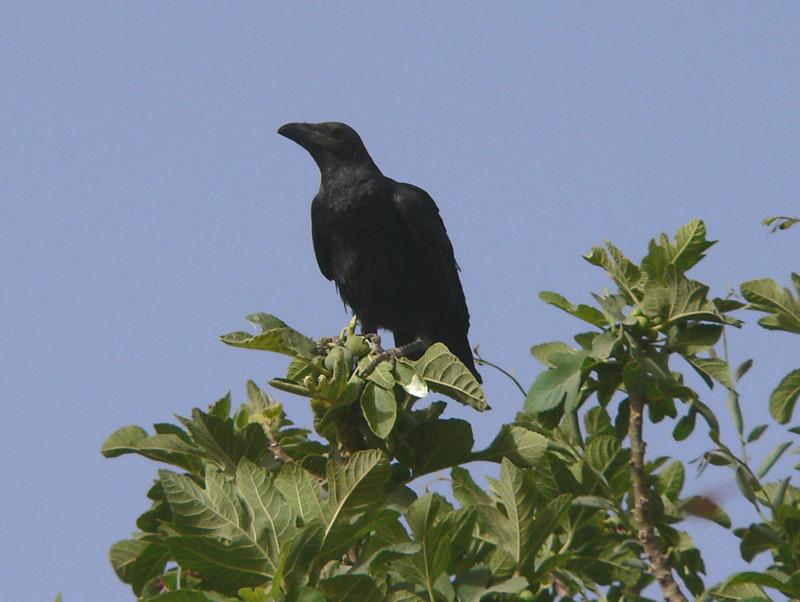|
| Query: Grasshopper | Result: 308th of 520 | |
Brown-necked Raven (Corvus ruficollis) - Wiki
| Subject: | Brown-necked Raven (Corvus ruficollis) - Wiki
| |

| Resolution: 1000x753
File Size: 146867 Bytes
Date: 2006:04:16 08:23:17
Camera: DMC-FZ20 (Panasonic)
F number: f/2.8
Exposure: 10/10000 sec
Focal Length: 720/10
Upload Date: 2007:12:03 10:13:39
|
Brown-necked Raven
From Wikipedia, the free encyclopedia
Order: Passeriformes
Family: Corvidae
[Photo] Brown-necked Raven (Corvus ruficollis) on fig tree, Timia, A??r Mountains, Niger. Date 16 April 2006. Author Christiaan Kooyman. License: public domain.
The Brown-necked Raven (Corvus ruficollis) is a larger bird (52-56 cm in length) than the Carrion Crow though not as large as the Common Raven. It has similar proportions to the common raven but the bill is not so large or deep and the wings tend to be a little more pointed in profile. The head and throat are a distinct brownish-black giving the bird its English name, while the rest of the plumage is black glossed with purple, blue or purplish-blue. The feathers of this species often fade quite quickly to a brownish black (even the truly black feathers) and the bird can look distinctly brown by the time it moults. The feet, legs and bill are black. The Dwarf Raven was formerly considered a subspecies (Corvus ruficollis edithae) but this bird now appears to be closer to the Pied Crow (Corvus albus) than this species and is found principally in Somalia and neighbouring areas.
This species has a wide range across virtually the whole of North Africa, down as far as Kenya, the Arabian peninsula and up into the Middle East and southern Iran. It lives in a predominantly desert environment visiting oases and palm groves.
Food consists of a wide range of items including carrion, snakes, locusts and other grasshoppers, stranded fish (in coastal areas), grain stolen from bags, dates and other fruits. It is quite fearless when not persecuted but is quick to become wary and shy if too much attention is paid to it.
The nest is very much like the Common Raven's, and may be found in trees, on cliffs or in old and ruined buildings. The Dwarf Raven seems to prefer thorn trees for its nest building. There are usually 4-5 eggs laid and incubated over 20-22 days. The young usually leave the nest by the 37th or 38th day and can fly well by 42-45 days.
The voice is very similar to the Common Raven's consisting mainly of croaks, though higher in pitch; and a harsh "karr-karr-karr" very much like a Carrion Crow too. In flight, it will utter a "kuerk-kuerk" call.
http://en.wikipedia.org/wiki/Brown-necked_Raven
| The text in this page is based on the copyrighted Wikipedia article shown in above URL. It is used under the GNU Free Documentation License. You may redistribute it, verbatim or modified, providing that you comply with the terms of the GFDL. |
|
Comments |
|---|
| | Guest |
|
| You guys suck dick |
^o^
Animal Pictures Archive for smart phones
^o^
|
|
|

